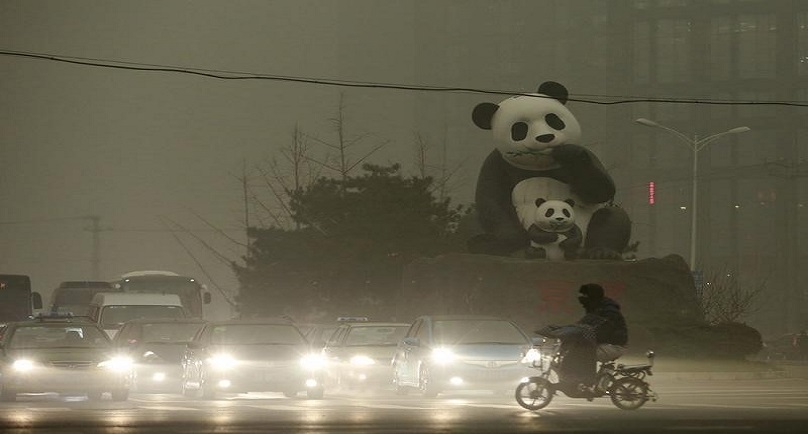Image:A resident rides an electric bicycle across a street amid heavy smog as vehicles wait for a traffic light next to a statue of pandas, a landmark of the Wangjing area in Beijing, China, December 1, 2015. REUTERS/China Daily
By Kathryn Doyle
(Reuters Health) – Infants exposed to higher levels of vehicular air pollution more often have problems later on in the small airways near the edges of their lungs, according to a new study.
The finding that early life exposure to air pollutants affects the so-called peripheral airways, “has not been reported before,” said lead author Dr. Erica S. Schultz of the Karolinska Institutet Institute of Environmental Medicine in Stockholm, Sweden.
“The lungs and airways are exposed to different air pollutants throughout life, but as the lungs are not fully developed at birth, young children are considered to be particularly vulnerable to adverse effects,” she said.
Because the effects are small, they may have little impact on healthy people living in areas with little pollution, Schultz and her coauthors write.
But the findings may be relevant in areas with high pollution levels and for people with respiratory conditions.
The researchers studied roughly 2,400 children recruited between 1994 and 1996 in Sweden for whom they had data on air pollution exposure as infants and lung function as teens. In particular, they studied the “resistance” in the teen’s peripheral airways, or how hard it is to get air through those passages.
The researchers focused on nitrogen oxides in vehicle exhaust and particulate matter from road erosion. They used records of road traffic, meteorological conditions and topography to model pollution levels at residential and school addresses for the kids in the first year of life and for the year prior to their 16th birthdays.
As infant exposure to nitrogen oxides increased by 10 micrograms per cubic meter, teen airway resistance also increased. The association was strongest for boys and for those with asthma at age 16.
Pollution exposure at ages 15 and 16 was not related to lung function, however.
The authors reported in the Journal of Allergy and Clinical Immunology that particulate matter did not have a significant relationship with airway resistance.
“An increasing amount of studies demonstrate the importance of airway periphery for lung health,” Schultz told Reuters Health by email. “What´s concerning is that the effect from first year of life seem to be long-lasting although we yet don’t know the full clinical implication of this effect.”
Most teens would not feel any symptoms of their reduced lung function as the effect was small, she said.
Stockholm has relatively low air pollution levels, she said. For more polluted cities, the effects may be greater and cause conditions like asthma, heart attacks, strokes and early death.
“From this study, we cannot say that children with asthma or any other respiratory conditions will become worse from current exposure, even though that has been reported from several other studies,” Schultz said.
But policymakers should take traffic air pollution levels into considerations when planning for housing, schools and daycare centers, she said.
SOURCE: http:https:https://bit.ly/20wLuxb Journal of Allergy and Clinical Immunology, online May 7, 2016.
Copyright 2016 Thomson Reuters. Click for Restrictions.


